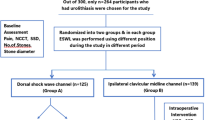Abstract
The aim of our study was to evaluate the efficacy and safety of ESWL using a modified lateral position in obese patients with renal stones. Nineteen obese patients with renal stones were enrolled (group A). The mean stone diameter was 1.3 cm (0.7–1.9 cm). The mean BMI was 35.1 kg/m² (31–41 kg/m²). Patients were placed in the lateral position, with the energy source facing their body posteriorly and the site where the stone was located in direct contact with the water cushion. Success rate (defined as the percentage of patients who were stone-free or with insignificant fragments after 3 months), mean number of ESWL sessions, mean duration of ESWL session and complications were recorded. The results were compared with those of 17 obese patients (Group B) with similar baseline characteristics treated in the standard supine position. All ESWLs were performed using the Dornier lithotripter SII. Both success rate (68.4 vs. 64.7% for groups A and B, respectively) and mean number of sessions (2.2 vs. 2.6) did not differ significantly between the two groups (p = 0.5). Interestingly, the time required to complete ESWL was significantly shorter for group A patients (56 min) compared to group B (73 min) (p = 0.001). No severe complications (including hematoma, pyelonephritis) were recorded. Our data indicate that ESWL in the modified lateral position for renal calculi in obese patients seems to be feasible and safe. In addition, it is faster than in the supine position since it overcomes technical difficulties. Further studies with a large number of patients are required to support our findings.


Similar content being viewed by others
References
Brodsky JB, Lemmens HJ, Brock-Utne JG, Vierra M, Saidman LJ (2002) Morbid obesity and tracheal intubation. Anesth Analg 94:732–736 (table of contents)
Bultitude MF, Tiptaft RC, Dasgupta P, Glass JM (2004) Treatment of urolithiasis in the morbidly obese. Obes Surg 14:300–304
Calvert RC, Burgess NA (2005) Urolithiasis and obesity: metabolic and technical considerations. Curr Opin Urol 15:113–117
Choban PS, Flancbaum L (1997) The impact of obesity on surgical outcomes: a review. J Am Coll Surg 185:593–603
Delakas D, Karyotis I, Daskalopoulos G, Lianos E, Mavromanolakis E (2003) Independent predictors of failure of shockwave lithotripsy for ureteral stones employing a second-generation lithotripter. J Endourol 17:201–205
El-Assmy AM, Shokeir AA, El-Nahas AR, Shoma AM, Eraky I, El-Kenawy MR, El-Kappany HA (2007) Outcome of percutaneous nephrolithotomy: effect of body mass index. Eur Urol 52:199–204
Faerber GJ, Goh M (1997) Percutaneous nephrolithotripsy in the morbidly obese patient. Tech Urol 3:89–95
Flegal KM, Carroll MD, Kuczmarski RJ, Johnson CL (1998) Overweight and obesity in the United States: prevalence and trends, 1960–1994. Int J Obes Relat Metab Disord 22:39–47
Kaminsky J, Gadaleta D (2002) A study of discrimination within the medical community as viewed by obese patients. Obes Surg 12:14–18
Koo BC, Burtt G, Burgess NA (2004) Percutaneous stone surgery in the obese: outcome stratified according to body mass index. BJU Int 93:1296–1299
Mezentsev VA (2005) Extracorporeal shock wave lithotripsy in the treatment of renal pelvicalyceal stones in morbidly obese patients. Int Braz J Urol 31:105–110
Mitsogiannis IC, Anagnostou T, Tzortzis V, Karatzas A, Gravas S, Poulakis V, Melekos MD (2008) Analgesia during extracorporeal shockwave lithotripsy: fentanyl citrate versus parecoxib sodium. J Endourol 22:623–626
Negri E, Pagano R, Decarli A, La Vecchia C (1988) Body weight and the prevalence of chronic diseases. J Epidemiol Community Health 42:24–29
Pareek G, Armenakas NA, Panagopoulos G, Bruno JJ, Fracchia JA (2005) Extracorporeal shock wave lithotripsy success based on body mass index and Hounsfield units. Urology 65:33–36
Pareek G, Hedican SP, Lee FT Jr, Nakada SY (2005) Shock wave lithotripsy success determined by skin-to-stone distance on computed tomography. Urology 66:941–944
Patel T, Kozakowski K, Hruby G, Gupta M (2009) Skin to stone distance is an independent predictor of stone-free status following shockwave lithotripsy. J Endourol 23:1383–1385
Pearle MS, Nakada SY, Womack JS, Kryger JV (1998) Outcomes of contemporary percutaneous nephrostolithotomy in morbidly obese patients. J Urol 160:669–673
Ramey SL, Franke WD, Shelley MC 2nd (2004) Relationship among risk factors for nephrolithiasis, cardiovascular disease and ethnicity: focus on a law enforcement cohort. AAOHN J 52:116–121
Robert M, A’Ch S, Lanfrey P, Guiter J, Navratil H (1999) Piezoelectric shockwave lithotripsy of urinary calculi: comparative study of stone depth in kidney and ureter treatments. J Endourol 13:699–703
Taylor EN, Stampfer MJ, Curhan GC (2005) Obesity, weight gain and the risk of kidney stones. JAMA 293:455–462
Thomas R, Cass AS (1993) Extracorporeal shock wave lithotripsy in morbidly obese patients. J Urol 150:30–32
Author information
Authors and Affiliations
Corresponding author
Rights and permissions
About this article
Cite this article
Karatzas, A., Gravas, S., Tzortzis, V. et al. Feasibility and efficacy of extracorporeal shock-wave lithotripsy using a new modified lateral position for the treatment of renal stones in obese patients. Urol Res 40, 355–359 (2012). https://doi.org/10.1007/s00240-011-0416-4
Received:
Accepted:
Published:
Issue Date:
DOI: https://doi.org/10.1007/s00240-011-0416-4




